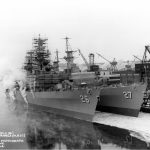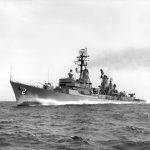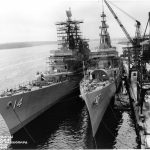BIW’s first ships of this era were the Dewey and Preble, hulls 333 and 334, ordered in late 1956. Members of the 10-ship Farragut class, these large destroyers were officially designated as “destroyer leaders” or “frigates” (DLGs), and their design was derived from the earlier Mitscher class frigates built at BIW. Perhaps because of this familiarity with the design, and despite being the last of their class ordered, BIW’s ships were the first delivered and commissioned in 1959-1960.
The frigates were closely followed by four Charles F. Adams class guided missile destroyers (DDGs), including the lead ship of the class, ordered in 1957 and 1958. The design of these ships was based on the familiar Sherman class destroyers, again substituting missiles for some guns. BIW’s ships, hulls 335-338, were delivered in 1960-1961, and were forerunners of 23 ships of the class for the US Navy.
Next in line were three Leahy class frigates (DLGs) ordered in 1958. These ships were completely new, larger, and for the first time designed entirely for guided missiles, with no significant gun armament. BIW received contracts for only three of nine ships in the class, reflecting increasingly stiff competition for declining shipbuilding work, as more yards fought for a smaller number of ships.
The challenges of constrained budgets and competition were again evident in the Belknap class DLGs awarded in 1961. The ships were designed as a cheaper version of the prior Leahy class, and BIW’s bids were so low that there was little chance of making a profit, but five of nine ships in the class were contracted to BIW and were delivered in 1964-1967.
After several years of building large, expensive destroyers or frigates, the Navy again turned to smaller, cheaper destroyer escorts. In 1962 BIW was outbid on contracts for nine ships, but won three Brooke class guided missile destroyer escorts in 1963, following an experimental version of the same design, the Glover, contracted in 1961.
While there seemed to be great promise in these contracts, the Brooke class was soon deemed “too expensive” and cut short, and the Glover turned into a complex technology development project. BIW was entirely outbid for the next group of “cheaper” ships the 46-ship Knox class, whose construction kept other shipyards busy well into the 1970’s.
The ships mentioned above, and their sister ships built elsewhere, formed the bulk of the US Navy’s destroyer-type fleet during the early Cold War era. After roughly 30 years of service, they were all retired in the early 1990’s as the Cold War ended and the new Arleigh Burke class destroyers came online. Of these ships, only Charles F. Adams remains in existence today, moored in Philadelphia awaiting scrapping.
The final ships of this era were three variants of the Charles F. Adams class DDGs, built for West Germany and delivered in 1969-1970. These ships hold a unique place in BIW history as the only warships built for a foreign navy. They enjoyed a relatively long life in German service, with two ships serving until 2003 and one, the Molders, surviving today as a museum.





